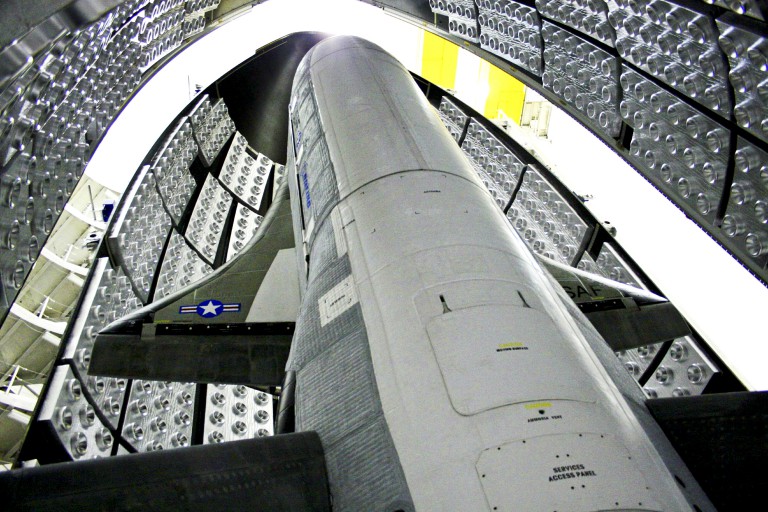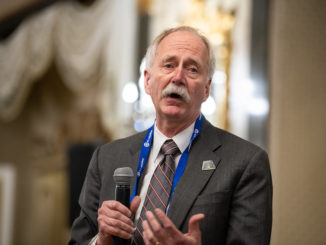
A month after an X-37B mini-space shuttle glided to a landing on Kennedy Space Center’s runway in Florida, the U.S. Air Force announced Tuesday that the spaceplane’s next mission will launch in August aboard a SpaceX Falcon 9 rocket for the first time.
The previously-unannounced launch agreement will use a Falcon 9 rocket to loft one of the Air Force’s two Boeing-built X-37B spaceplanes, reusable craft that have circled Earth for a combined 2,085 days on four previous flights.
Air Force Secretary Heather Wilson, displaying a model of the unpiloted spaceplane, disclosed the service’s launch plans for the fifth X-37B mission during a Senate Armed Services Committee hearing Tuesday.
“This is the model of the X-37, which will be going up again,” Wilson said. “It’s a reusable vehicle and will be going up again on top of a SpaceX launcher in August.”
Managed by the Air Force’s Rapid Capabilities Office, the X-37Bs are about one-quarter the size of a space shuttle orbiter. Built by Boeing’s Phantom Works division, each spaceship has a wingspan of nearly 15 feet (4.5 meters) and a length of more than 29 feet (8.9 meters).
The X-37B weighs about 11,000 pounds (5 metric tons) and has typically orbited Earth at altitudes between 200 and 250 miles (320 to 400 kilometers).
The X-37Bs, also known as the Orbital Test Vehicle, take off nestled inside the payload fairing of a conventional rocket, then open payload bay doors and deploy a power-generating solar panel in orbit. The spaceplanes glide back to Earth for a runway landing.

The craft’s four previous missions lifted off on United Launch Alliance Atlas 5 rockets from Cape Canaveral, each mission spending progressively longer periods in orbit.
The X-37Bs took off inside the short version of the Atlas 5 rocket’s 5-meter-class payload fairing without the aid of strap-on solid rocket boosters, a configuration ULA calls the Atlas 5-501. The Falcon 9’s standard payload shroud is approximately the same diameter and length of the Atlas 5’s short 5-meter fairing.
The most recent flight, named OTV-4, ended May 7 with the X-37B’s first touchdown on the former space shuttle landing strip at NASA’s Kennedy Space Center in Florida after 718 days in orbit. The previous three missions landed at Vandenberg Air Force Base in California, but the Air Force and Boeing have relocated X-37B launch, landing and processing operations to the Florida spaceport, taking over two former space shuttle hangars near the iconic Vehicle Assembly Building.
The X-37B’s missions in space are largely secret, and the robotic spaceship’s landing last month was the first time the Air Force did not announce the craft’s scheduled return ahead of time. Breaking with disclosures ahead of earlier flights, the Air Force also did not reveal which of the two spaceplanes flew the OTV-4 mission.
Military officials did not identify Tuesday which spacecraft is slated for the fifth X-37B flight.
“We are very excited for the next fifth X-37B mission,” said Randy Walden, the director of the Air Force Rapid Capabilities Office. “We look forward to continued expansion of the vehicle’s performance and are excited to continue hosting experimental payloads for the space community.”

The Air Force said in a statement Tuesday that the fifth X-37B flight will include several firsts.
“This mission will be the program’s first launch on a SpaceX Falcon 9 Upgrade launch vehicle,” the Air Force said. “The program also continues to build upon its fourth mission collaboration with experiment partners.”
The Air Force Research Laboratory will test experimental electronics and oscillating heat pipes on the X-37B’s fifth long-duration spaceflight, military officials said.
Other objectives of the flight remain secret.
“The ability to launch the Orbital Test Vehicle on multiple platforms will ensure a robust launch capability for our experiment designers,” Walden said in a statement. “We are excited about this new partnership on creating flexible and responsive launch options and are confident in SpaceX’s ability to provide safe and assured access to space for the X-37B program.”
SpaceX’s Falcon 9 rocket was certified by the Air Force to launch the military’s sensitive and costly national security payloads in 2015. Since that milestone, the Air Force has awarded contracts to SpaceX for launches of two Global Positioning System navigation satellites, and at least a dozen more launch contracts are up for grabs by SpaceX and ULA through 2019.

Before SpaceX was certified, the Air Force gave launch contracts ULA in sole-source “block buy” awards.
But the rocket contract for the fifth X-37B mission was not listed in a roster of planned competitive space launch procurements provided by Air Force officials in recent months.
SpaceX has up to a half-dozen launches on its schedule before the X-37B mission in August, primarily deployments of commercial communications satellites. The company aims to resume flights from Cape Canaveral’s Complex 40 launch pad by September after crews repair damage to the facility from a Falcon 9 rocket explosion in September.
Until then, all Falcon 9s launched from Florida will take off from pad 39A at Kennedy Space Center, the starting point for the Apollo moon missions and most space shuttle flights.
Officials have not specified which Florida launch pad will host the Falcon 9’s liftoff with the fifth X-37B flight, and SpaceX said last week that they have not determined which mission will be the next to depart from pad 40.
Wilson, who has been the top civilian in the Air Force for three weeks, told lawmakers Tuesday the hotly-competitive U.S. launch market is driving launch prices down, giving the military two certified contractors to ensure a backup provider is available if one launch vehicle runs into trouble.
The Pentagon instituted the “assured access to space” policy after a string of launch failures in the 1990s, and ULA’s Atlas and Delta rocket fleets offered the military launch redundancy until SpaceX’s Falcon 9 arrived on the market.
“We had a huge problem in the 1990s with access to space, and the country, at that time, made a significant investment in space capability, and the ability to launch, and it paid off and is showing results,” Wilson said. “The benefit now is that we’re seeing competition, and it’s bringing the price down for access to space.”
Email the author.
Follow Stephen Clark on Twitter: @StephenClark1.



